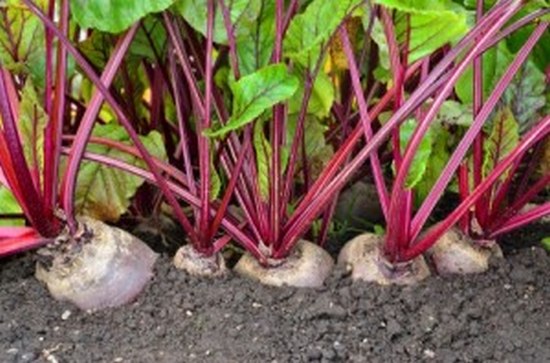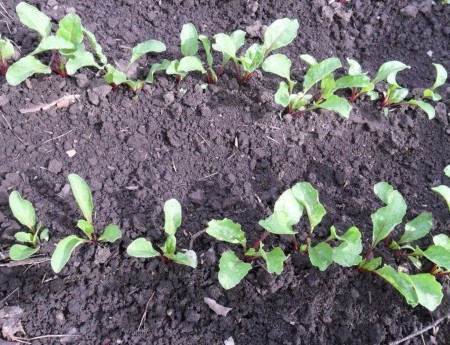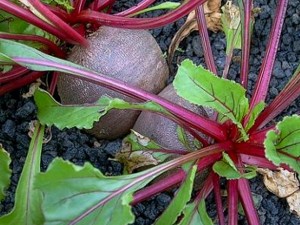Beetroot is a biennial plant. In the first year after planting, the plant grows a root crop and a large rosette of leaves. And already in the second year it produces flower stems and seeds.
The size, shape and weight of root crops vary and depend on growing conditions and variety. The shape can be round, conical and even spindle-shaped, and the skin and pulp have different colors.On average, 3-4 kg of root crops can be harvested from 1 m2, but many vegetable growers achieve an increase in yield to 4.5-6 kg from 1 m2.
Which neighbors should I plant beets with? It is believed that this root vegetable does not grow well next to corn. Increased productivity can be achieved if it is planted close to beans, tomatoes, potatoes and spinach. Beets also grow well when planted next to lettuce, radishes, radishes, onions, kohlrabi and garlic.
Temperature
Seeds germinate at + 5 - 6 degrees, seedlings at this temperature will appear in two weeks. They withstand short-term cold snaps down to -2 degrees quite well. And adult plants can withstand frosts down to -4 degrees. The optimal temperature for plant development is 18 - 20 degrees. But when beets begin to form roots, the need for heat increases. During this period, the optimal air temperature is 20-25 °C.
Planting beets
Where is the best place to plant? It is best to plant beets on loose, well-moistened and aerated loamy soils with a low groundwater level. On alkaline and acidic soils the plant gives a poor harvest.
Beetroot is a light-loving plant. When there is insufficient sunlight, plants become stretched and their yield decreases. Therefore, choose well-lit places for planting.
Planting beets video
Soil preparation. Apply organic fertilizers to the area selected for planting a year before. If you were unable to do this, add humus or compost immediately before sowing at the rate of 2-4 kg per 1 m2. If the soil on the site is acidic, add lime in the fall at the rate of 300-700 g per 1 m2. Apply mineral fertilizers in the fall as well.
When to plant. Plant beets in the spring, when the soil temperature rises to 5-6 °C. If you want to speed up the emergence of seedlings, pre-soak the seeds for one day in water, and then keep them at +18-20 ° C until single seedlings appear. Lightly dry the seeds before planting.
If you want not only to reduce the time of seed germination and increase their germination, but also to get a large beet harvest in the future, carry out bubbling - saturating the seeds in water with oxygen for 12 hours.
How to plant. Plant beets in three rows on the beds, plant the seeds to a depth of 4-5 cm. If the soil on your site is heavy, plant the seeds to a depth of no more than 3 cm.
The beet harvest often depends on the weather. Sometimes the crops of this plant freeze. If you have already encountered such a problem, plant beets in two periods: at the beginning and at the end of May. If the first crops freeze or begin to shoot, you will have the second ones, from which you are guaranteed to get a harvest.
Beet care
Caring for beets consists of thinning seedlings, loosening the soil, regular watering and fertilizing of plants.
Thinning of plantings.
Beets are thinned twice. The first time, thin out the plants in the phase of 2 true leaves (7-10 days after emergence). The distance between the sprouts should be 3-4 cm. Thin the second time in the phase of 3-4 true leaves. This time, make sure that the plants are at a distance of 8-10 cm from one another.
It is best to carry out thinning in the evening after watering or rain: the plant can be easily pulled out of damp soil. Although you don’t have to pull it out, but just pinch it at the soil level.This method prevents damage to the root system of the plants remaining in the garden bed.
If, during thinning, you pull out plants in order to transplant them to another bed, remember that varieties with elongated roots should not be picked. When transplanting such plants, their integrity is violated and as a result, deformed and ugly root crops are formed. But picking does not affect the quality of the round root crop.
How to plant beets video.
Tillage
When caring for beets, pay great attention to loosening and avoid the formation of a soil crust. At first, loosen the soil to a depth of 3-5 cm, gradually increase the loosening depth to 10 cm. If root crops peek out of the ground, they should be spudded.
How to water
The most important thing in caring for any plant is regular watering. Beets are a moisture-loving plant. The beds should be well moistened before planting and watered immediately after sowing. Water regularly throughout the summer season. It is best to irrigate using the sprinkling method. During the formation and growth of root crops, do not allow long breaks between waterings. A month before harvesting, watering should be stopped.
How to feed beets
During the season, two or three feedings should be carried out.
- Do the first one immediately after thinning. For this you will need nitrogen fertilizers at the rate of 10-15 g per 1 m2.
- After the second thinning, add ammonium nitrate (15 g per 1 m2) to the soil.
- After 15-20 days, when root crops begin to form, superphosphate and potassium chloride (7.5-10 g per 1 m2).
Expert advice: how to grow sweet beets
Beets sprout and grow without problems even for novice gardeners, but not everyone turns out sweet and beautiful.True, those who understand its requirements annually receive a harvest of high-quality root crops.
- In order for beets to grow sweet, you need to choose the right variety. Domestic varieties have long taken root in our gardens Bordeaux, Incomparable, Red Ball and etc.
- Try to plant it in a well-lit bed. In the shade of trees, under the canopy of corn and sunflowers, unsweetened, poorly colored root crops grow.
- The plant is also demanding on soil fertility, although it should not be sown immediately after applying manure: the formation of root crops will be delayed, and the quality will be low, as they say, neither taste nor appearance. In addition, on manured soil, the plant is often affected by fungal diseases. But being sown after crops to which organic matter was added (cucumbers, cabbage), beets will form high-quality, tasty root crops.
- When digging up a future beet bed, add up to two tablespoons of superphosphate, 1-1.5 tablespoons of potassium sulfate or a tablespoon of nitrophoska and a glass of wood ash per square meter. m.
- In order for beets to gain “sweetness” and grow without defects, they are fed with fertilizers containing magnesium and boron, for example, magbor. To ensure that beets do not lack other nutrients, at the beginning of the growing season they are fed with complex fertilizer (a tablespoon per square meter). Nitrogen is added if leaves grow weakly in spring: 2 teaspoons of urea per square meter. m. During the phase of root crop formation, repeat fertilizing with complex fertilizer.
- At the end of the season, “for sweetness,” the beets are “salted”: fed with table salt (a teaspoon per bucket of water).
- Beautiful root crops cannot be grown without timely thinning of the seedlings.This plant has the property of sprouting in clusters, even if, when sowing, you place the seed balls at the required distance. Therefore, at the stage of 2-3 true leaves, the seedlings are thinned out, increasing the distance between plants to 3-4 cm. After 2-3 weeks, another thinning is carried out - up to 6-7 cm. “Rare” is also not needed: the root crops will grow too large , their quality will deteriorate.
As you can see, caring for beets is not much different from caring for all other root vegetables. If you follow all these simple recommendations in the fall, you will get an excellent harvest.





 (60 ratings, average: 4,62 out of 5)
(60 ratings, average: 4,62 out of 5) CUCUMBERS NEVER GET SICK, I'VE BEEN USING ONLY THIS FOR 40 YEARS! I SHARE A SECRET WITH YOU, CUCUMBERS ARE LIKE THE PICTURE!
CUCUMBERS NEVER GET SICK, I'VE BEEN USING ONLY THIS FOR 40 YEARS! I SHARE A SECRET WITH YOU, CUCUMBERS ARE LIKE THE PICTURE! You can dig a bucket of potatoes from each bush. Do you think these are fairy tales? Watch the video
You can dig a bucket of potatoes from each bush. Do you think these are fairy tales? Watch the video
 How our fellow gardeners work in Korea. There is a lot to learn and just fun to watch.
How our fellow gardeners work in Korea. There is a lot to learn and just fun to watch. Eye trainer. The author claims that with daily viewing, vision is restored. They don't charge money for views.
Eye trainer. The author claims that with daily viewing, vision is restored. They don't charge money for views. A 3-ingredient cake recipe in 30 minutes is better than Napoleon. Simple and very tasty.
A 3-ingredient cake recipe in 30 minutes is better than Napoleon. Simple and very tasty. Therapeutic exercises for cervical osteochondrosis. A complete set of exercises.
Therapeutic exercises for cervical osteochondrosis. A complete set of exercises. Which indoor plants match your zodiac sign?
Which indoor plants match your zodiac sign? What about them? Excursion to German dachas.
What about them? Excursion to German dachas.
Thank you, Richard! This is my first time on the site - a great help! Everything is detailed, clear and accessible. Beautiful design, good video, THANK YOU again!
I can suggest going to the site, where there is a lot of information on the topic that interests you.